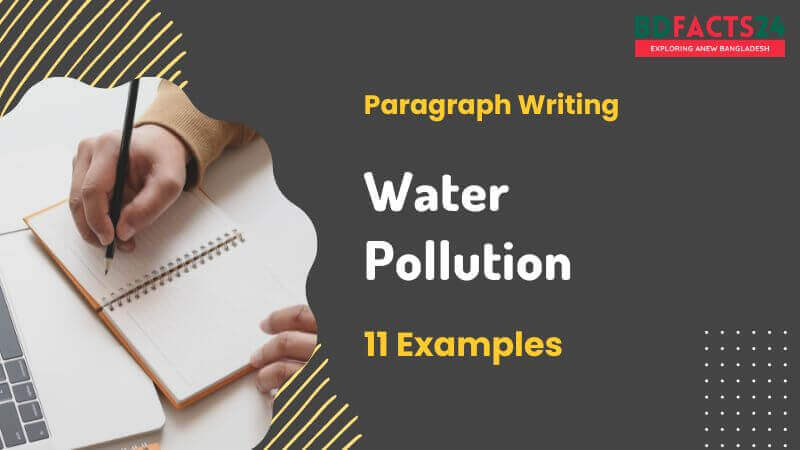Paragraph writing is an essential skill that every student must master, as it is a fundamental part of academic writing.
In this article, we will look at examples of paragraph about “Water Pollution” that students can reference when writing paragraphs about water pollution, a significant problem in Bangladesh.
Example 01
Water pollution is a severe problem in Bangladesh, which is home to some of the world’s most densely populated and heavily industrialized areas. The country is situated on the delta of three major rivers, the Ganges, Brahmaputra, and Meghna, which all eventually flow into the Bay of Bengal.
This makes Bangladesh particularly vulnerable to water pollution from both industrial and agricultural sources. The discharge of untreated industrial effluent, pesticides, and fertilizers into the rivers has led to a significant decline in water quality, threatening aquatic life and making water sources unsafe for human consumption. The problem is compounded by inadequate infrastructure for wastewater treatment and poor management of solid waste.
As a result, waterborne diseases like cholera and diarrhea are widespread, particularly in rural areas, and access to safe drinking water remains a significant challenge. The Bangladesh government and international organizations have implemented various programs and policies to address the issue of water pollution, but the problem remains a significant threat to public health and the environment.
Example 02
Water pollution is a significant problem in Bangladesh, as the country is home to several large rivers and an extensive network of waterways. Much of the pollution in Bangladesh’s water sources results from industrial activities, agricultural runoff, and untreated sewage. In particular, the textile industry has been identified as a major contributor to water pollution in the country.
Many factories discharge their untreated waste directly into the rivers, leading to high levels of toxic chemicals and heavy metals in the water. This pollution has had a devastating impact on the health and livelihoods of millions of people living along these waterways, including increased rates of waterborne diseases and reduced access to clean drinking water.
The government of Bangladesh has taken steps to address this issue by implementing regulations on industrial waste discharge and investing in wastewater treatment facilities. However, much work remains to be done to fully address the problem of water pollution in Bangladesh and protect the health and well-being of its citizens.
Example 03
Water pollution is a major environmental issue in Bangladesh, with a significant impact on the health and wellbeing of its people. The country’s rapid industrialization, urbanization, and population growth have led to increased water usage and a corresponding rise in pollution levels. The major sources of water pollution in Bangladesh include industrial effluents, sewage, and agricultural runoff.
The lack of proper waste management systems and lax enforcement of environmental regulations exacerbate the problem. The polluted water not only affects human health but also harms aquatic life and degrades the ecosystem. Many people in Bangladesh rely on contaminated water sources for drinking, cooking, and bathing, leading to waterborne diseases such as cholera, typhoid, and diarrhea.
To address this issue, there is an urgent need for comprehensive policies and strategies to reduce pollution levels and improve water quality. This includes promoting sustainable practices in industries, enforcing environmental laws, increasing public awareness of the importance of clean water, and investing in infrastructure to provide safe drinking water to all citizens.
Example 04
Water pollution in Bangladesh is a critical environmental challenge that poses significant health risks to the population. The country’s rapid economic growth has led to increased industrialization, urbanization, and agricultural activities, all of which contribute to the degradation of water quality. Rivers, ponds, and other surface water bodies are particularly vulnerable to pollution from pesticides, fertilizers, untreated sewage, and industrial effluents.
As a result, many people in Bangladesh rely on unsafe sources of water for their daily needs, leading to a range of health problems, including diarrheal diseases, skin infections, and respiratory illnesses. Moreover, water pollution also affects aquatic biodiversity, disrupts ecosystems, and reduces the productivity of fisheries. Addressing water pollution in Bangladesh requires concerted efforts from the government, private sector, and civil society.
Critical interventions include improving water monitoring systems, enforcing environmental standards, promoting sustainable agriculture practices, and investing in wastewater treatment facilities. By taking action to reduce water pollution, Bangladesh can improve the health and wellbeing of its citizens as well as protect its natural resources for future generations.
Example 05
Bangladesh, a country situated on the delta of several major rivers, faces significant challenges in combating water pollution. The country’s economy relies heavily on its water resources, which are under pressure from a range of pollutants. Industrial effluents, agricultural runoff, and untreated sewage are among the most significant sources of water pollution.
The situation is particularly severe in the country’s urban areas, where rapid population growth and industrialization have led to the degradation of water quality. The Buriganga River, which runs through the capital city of Dhaka, is one of the most polluted rivers in the world. The impacts of water pollution on public health are severe, with waterborne diseases being a major cause of illness and death.
The government of Bangladesh has made efforts to address the problem, including improving wastewater treatment and promoting better waste management practices. Despite these efforts, much remains to be done to ensure that the country’s water resources are protected for the benefit of both people and the environment.
Example 06
Water pollution is a pervasive problem in Bangladesh, primarily due to the limited availability of clean water sources and high population density. The country’s rivers, lakes, and wetlands are heavily contaminated with industrial effluents, agricultural runoff, and domestic sewage, posing a significant threat to human health and environmental sustainability.
Waterborne diseases such as cholera, typhoid, and hepatitis A are prevalent in many parts of the country, particularly among vulnerable populations such as children and the elderly. Furthermore, water pollution has adverse effects on aquatic ecosystems, leading to reduced biodiversity and ecological imbalance. Addressing water pollution in Bangladesh requires a multi-pronged approach that includes improving access to safe drinking water and promoting sustainable farming practices.
The government must also enforce environmental regulations strictly and invest in wastewater treatment facilities to mitigate the negative impacts of pollution on public health and natural resources. Educational campaigns aimed at raising awareness about the dangers of water pollution can also play a vital role in driving behavior change and reducing pollution levels.
Example 07
Water pollution is an ongoing concern in Bangladesh, a country heavily reliant on its rivers and water resources for both economic and social purposes. Unfortunately, this dependence has also led to severe pollution in these water sources. Industrial waste, agricultural runoff, and untreated sewage are the most significant sources of pollution, impacting the health of aquatic life and humans alike.
The high level of pollution in the Buriganga River has made it a major concern for both the public and policymakers. The lack of proper wastewater treatment and waste management practices have only worsened the situation. The government has launched various initiatives to tackle the problem, including providing better access to safe drinking water and improving wastewater treatment.
Despite these efforts, water pollution remains a significant challenge, threatening the health and wellbeing of Bangladeshis and the country’s environment. Addressing the issue requires a concerted effort from all stakeholders, including the government, industry, and the public, to adopt more sustainable practices and ensure the long-term health of the country’s water resources.
Example 08
Bangladesh has long been grappling with the issue of water pollution, which poses a significant threat to public health and environmental sustainability. The country’s rapid industrialization and population growth have led to increased demand for water resources and a corresponding rise in pollution levels.
The major sources of water pollution include untreated sewage, agricultural runoff, and industrial effluents, which contaminate the rivers, streams, and groundwater that millions of people rely on for their daily needs. Exposure to contaminated water can lead to a range of illnesses, including diarrheal diseases, skin infections, and respiratory problems. The situation is further exacerbated by climate change, which has led to more frequent floods and droughts, making it more challenging to manage water resources effectively.
To address this problem, there is an urgent need for stronger regulatory frameworks, better infrastructure, and increased public awareness about the importance of clean water. By taking action to reduce pollution levels and improve water quality, Bangladesh can safeguard the health and wellbeing of its citizens and protect its natural resources for future generations.
Example 09
Water pollution is a pervasive problem in Bangladesh, a country with a dense population and a significant dependence on water resources for agriculture, fisheries, and industrial activities. The major rivers in Bangladesh, including the Ganges, Brahmaputra, and Meghna, are highly polluted due to discharges from industries, agricultural runoff, and untreated sewage.
As a result, the quality of the water has declined, posing a serious threat to human health and the environment. The pollution levels in the Buriganga River in Dhaka have reached alarming levels, making it one of the most polluted rivers in the world. The adverse effects of water pollution are felt acutely by the poorer sections of society, who lack access to safe drinking water and adequate sanitation facilities.
The government has taken several steps to address the issue of water pollution, including stricter regulations, improving wastewater treatment facilities, and promoting alternative sources of energy. However, given the scale of the problem, a more significant effort is required to combat water pollution and ensure that Bangladesh’s water resources remain sustainable and healthy for future generations.
Example 10
Water pollution remains a significant challenge in Bangladesh, a country where water resources are critical for the livelihoods of millions of people. The country’s rivers, wetlands, and groundwater are under threat from a range of sources, including industrial and domestic waste, agricultural runoff, and poor sanitation practices.
The high levels of pollution have led to a decline in water quality, posing a significant threat to human health and the environment. The situation is particularly acute in urban areas, where rapid industrialization and population growth have put a severe strain on water resources. The government has taken steps to address the issue, including promoting sustainable waste management practices and investing in wastewater treatment facilities.
However, the challenges are enormous, and progress has been slow, particularly in rural areas where access to safe drinking water and sanitation facilities remains limited. Urgent action is required to ensure that Bangladesh’s water resources are adequately protected and that people have access to clean and safe water, particularly in light of the country’s vulnerability to climate change and its impact on water resources.














